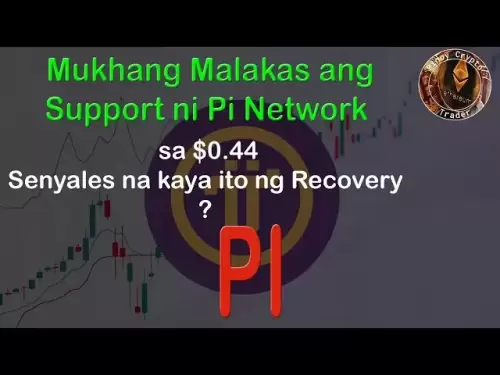 |
|
 |
|
 |
|
 |
|
 |
|
 |
|
 |
|
 |
|
 |
|
 |
|
 |
|
 |
|
 |
|
 |
|
 |
|
Cryptocurrency News Articles
Ethereum: Current Landscape and Future Outlook 2025
May 18, 2025 at 08:41 am
Ethereum remains a central pillar of the blockchain ecosystem as of 2025, continuing its evolution as a decentralized platform for smart contracts and decentralized applications (dApps).

Ethereum: Current Landscape and Future Outlook 2025Table of ContentsIntroduction to Ethereum
Ethereum remains a central pillar of the blockchain ecosystem as of 2025, continuing its evolution as a decentralized platform for smart contracts and decentralized applications (dApps). Launched in 2015 by Vitalik Buterin and co-founders, Ethereum introduced programmability to blockchain technology, enabling developers to build a broad array of applications beyond simple peer-to-peer transactions. Its native cryptocurrency, Ether (ETH), is the second-largest by market capitalization after Bitcoin, cementing Ethereum’s role as the backbone for decentralized finance (DeFi), non-fungible tokens (NFTs), and much of Web3 innovation.
In recent years, Ethereum has undergone significant technical upgrades, most notably the successful transition from Proof-of-Work (PoW) to Proof-of-Stake (PoS) via The Merge in September 2022. This pivotal change has drastically reduced Ethereum’s energy consumption by over 99% and paved the way for future scalability improvements. The Shanghai/Capella upgrade in 2023 introduced staking withdrawals, increasing network participation and flexibility for validators www.coindesk.com. 2024 and early 2025 have seen ongoing work on Ethereum’s roadmap, focusing on rollups, sharding, and other solutions to address congestion and high transaction fees, collectively known as “The Surge” and “The Scourge” phases ethereum.org.
Ethereum’s ecosystem continues to expand. Over 4,000 dApps are deployed on the network, and the total value locked (TVL) in DeFi protocols on Ethereum regularly exceeds $30 billion as of early 2025 defillama.com. The platform also remains the leading choice for NFT marketplaces and has inspired a wave of Layer 2 (L2) scaling solutions—such as Optimism, Arbitrum, and zkSync—which process transactions off-chain and settle them onto Ethereum, significantly increasing throughput and reducing costs www.theblock.co.
Looking ahead, Ethereum’s outlook for 2025 and beyond is shaped by its ongoing efforts to improve scalability, security, and decentralization. The implementation of sharding, anticipated to further enhance transaction speeds and lower costs, is expected to roll out in phases through 2025 and 2026. With institutional adoption growing and Ethereum serving as the infrastructure for digital assets, decentralized finance, and Web3, the network is poised to maintain its leadership role in the coming years www.coindesk.com. However, competition from alternative blockchains and regulatory changes remain key factors to watch as Ethereum continues to define the future of programmable money and decentralized applications.
Ethereum Technology Overview
Ethereum, the world’s leading programmable blockchain, continues its rapid evolution in 2025, building upon the pivotal transition to proof-of-stake (PoS) completed by The Merge in September 2022. The PoS model, which replaced energy-intensive mining, has reduced Ethereum’s energy consumption by over 99% and established the platform as a leader in sustainable blockchain infrastructure ethereum.org. In 2025, Ethereum’s core technological priorities revolve around scalability, security, and usability, with significant progress in each area.
Looking ahead, Ethereum’s technology trajectory focuses on scaling to support billions of users, enhancing developer tools, and fostering interoperability with other blockchains. The combination of PoS, rollups, and forthcoming sharding upgrades positions Ethereum to remain a foundational layer for decentralized finance (DeFi), NFTs, and emerging on-chain innovations through 2025 and beyond cointelegraph.com.
Key Developments Since Ethereum 2.0
Since the completion of the Ethereum 2.0 upgrade—culminating with the “Merge” in September 2022—Ethereum has undergone significant changes, solidifying its position as the leading smart contract platform. Key developments from 2023 through 2025 have focused on scalability, sustainability, and usability, reflecting both the network’s technical ambitions and the demands of its vibrant ecosystem.
Looking ahead, Ethereum’s focus is on scaling, accessibility, and sustainable innovation. With ongoing upgrades, the network is well-positioned to maintain its dominance and support a broadening array of decentralized applications through 2025 and beyond.
DeFi and NFT Ecosystem on Ethereum
In 2025, Ethereum remains the foundational infrastructure for decentralized finance (DeFi) and non-fungible token (NFT) ecosystems, maintaining its dominance despite growing competition from alternative layer-1 and layer-2 networks. The total value locked (TVL) in Ethereum DeFi protocols continues to account for a significant share of the market, with figures regularly exceeding $30 to $40 billion in early 2025, according to defillama.com.
Disclaimer:info@kdj.com
The information provided is not trading advice. kdj.com does not assume any responsibility for any investments made based on the information provided in this article. Cryptocurrencies are highly volatile and it is highly recommended that you invest with caution after thorough research!
If you believe that the content used on this website infringes your copyright, please contact us immediately (info@kdj.com) and we will delete it promptly.






























































